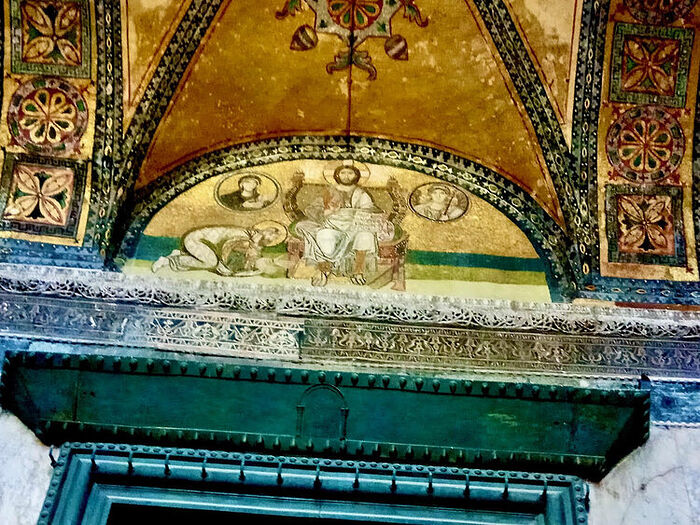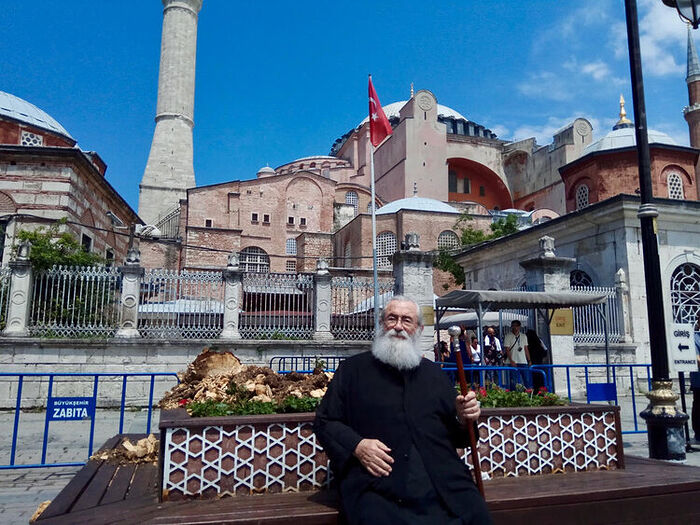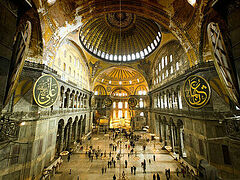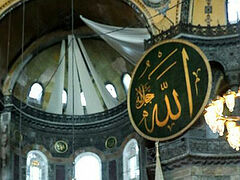 Above the main portal to Hagia Sophia, the builder of St. Catherine’s Monastery, Saint Justinian, offers the Church of the Wisdom of God to Christ.
Above the main portal to Hagia Sophia, the builder of St. Catherine’s Monastery, Saint Justinian, offers the Church of the Wisdom of God to Christ.
A voice of deep sorrow from the center of the Sinai desert, the Monastery of St. Catherine of the Holy and God-trodden Mountain of Sinai, a voice of brotherly prayer and petition.
Our Monastery, a sibling construction of the Temple of the Divine Wisdom of Constantinople – sharing the same builder, the Great Emperor St. Justinian – feels pain, oppression, and affliction that our sister Great Church, Saint Sophia, the boast of our ancestry, once again is defiled and led into degenerate captivity. With the help of God, under the protection of Saint Catherine, the Divine Liturgy has been celebrated in our holy Monastery ceaselessly for sixteen centuries; a period during which Hagia Sophia, captive to barbarian hands, was pillaged and despoiled. Atrocity was first wrought unfortunately by western Christianity from 1204 – 1261, 57 years which constituted the precursor of its ravaging by the Ottomans. Beginning in 1453, this continues until today, a period of desecration stretching to 567 years.
We are distressed because from the experience of our historic Monastery, daily life teaches that our Monastery and Hagia Sophia are not soulless constructions, the fruit of human vanity or overblown ambition, but incarnations of prayer and supplication. We are speaking of living organisms that mystically feel, suffer and groan with humanity. They comprise material symbols that raise up, express and mirror realities beyond those of common sensibilities, and reflect the hidden Beauty and Light of the Kingdom of the Triple-sunned Divinity. When the unbaptized representatives of the Rus, tenth-century ancestors of our fellow-believing Russians, entered Hagia Sophia for the first time, they avowed they had beheld heaven on earth. Whereas we Orthodox are so accustomed to the exalted comeliness of our temples, whether small or large (an indicator of the uncreated beauty of the Triune Divinity), it is as though we have blinded ourselves to the appreciation shown such splendors by our Russian Orthodox friends – to which, however, we are witnesses and heirs.
On one hand, the Western cosmos confronts the miracle of Hagia Sophia with humanistic criteria, focusing on its authentically artistic dimensions; on the other, having lost its sense of the sacred to its theology, it does not comprehend the meaning of desecration – the desecration to which Hagia Sophia is being held hostage.
 Archbishop Damianos in front of Hagia Sophia 2018.
Archbishop Damianos in front of Hagia Sophia 2018.
By what agreement with our own tradition, and the premises of its construction, however, do we descend to this level by referring to Hagia Sophia as a “monument,” as they do? A word which neither expresses it, because as a Temple it has another function; nor describes it, given that the word “monument” (in our own tongue, at least) carries the meaning of a burial plot. How odd and unfitting, then, is it to accept as a monument of the dead, an organism so alive as the great Church of Hagia Sophia?
If we grasp well that Hagia Sophia is a Holy Temple and indeed a beacon (symbol) for all of us; that the heart of our Orthodox heritage beats strongly, kneels reverently, and mystically liturgizes in the Temple of the Wisdom of God – only then are we worthy of her!
May we unite our strengths, our voices, and our prayers toward the Wisdom and Compassion of our Triune God, who has His earthly dwelling under His care, having preserved it whole for sixteen centuries, that He may once more preside over the storms which are breaking upon it and upon the wounded, from the ages, soul of our ethnicity … the soul which dwells within the innermost sanctuary of its magnificence through its history, traditions and values (freedom, democracy, Christian love and fellowship) … the soul that has remained true to them all with its own blood, throughout the course of its crucified path toward the Resurrection.




